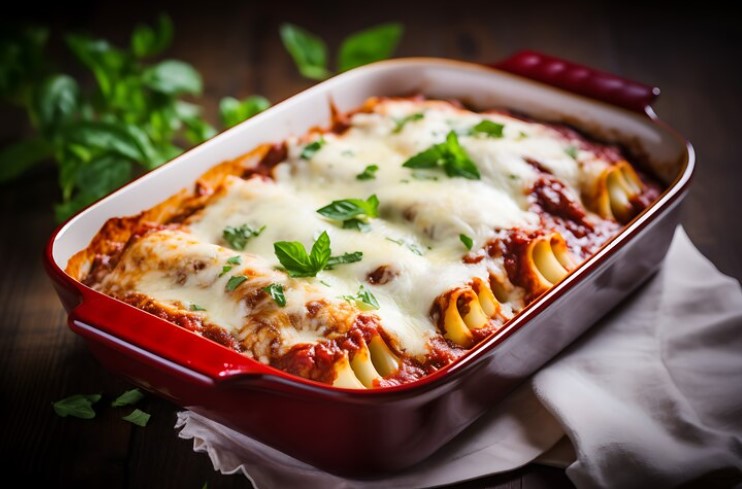Introduction: Ramen Lasagna Recipe
Embark on a culinary adventure with our Ramen Lasagna Recipe, a delightful fusion that marries the comforting layers of traditional Italian lasagna with the unique twist of Asian-inspired ramen noodles. This recipe is perfect for those looking to add an innovative and delicious dish to their cooking repertoire.
What Makes Ramen Lasagna Recipe Unique
Ramen Lasagna is not just a dish; it’s a statement. It combines the comforting layers of lasagna with the slurpy goodness of ramen, creating a dish that’s both familiar and excitingly new. Its versatility allows for endless customization, making it a favorite among both traditionalists and adventurers in the kitchen.
Ingredients
Preparation Ramen Lasagna Recipe
1. Preparing the Ingredients:
- Preheat your oven to 375°F (190°C).
- Cook the ramen noodles according to package instructions, minus 1 minute to keep them al dente. Drain and set aside.
- In a skillet, heat olive oil over medium heat. Add chopped onions and minced garlic, sautéing until translucent.
- If using meat, add ground beef or turkey to the skillet. Cook until browned, breaking it into small pieces. If opting for a vegetarian version, skip to the next step.
- Season the meat or sautéed onions with salt, black pepper, Italian seasoning, and red pepper flakes. Stir well.
- Pour in 2 cups of marinara sauce, mix, and let it simmer for about 5 minutes. Remove from heat.
2. Cheese Mixture:
- In a bowl, combine ricotta cheese, beaten eggs, half of the shredded mozzarella, and grated Parmesan. Mix until well blended.
3. Assembling the Lasagna:
- Grease a baking dish with butter.
- Spread a thin layer of the remaining marinara sauce on the bottom of the dish.
- Lay ramen noodles over the sauce to cover the bottom of the dish.
- Spread half of the meat or vegetable mixture over the noodles.
- Spoon and spread half of the cheese mixture over the meat/vegetables.
- Repeat the layers: noodles, the remaining meat/vegetable mixture, and the remaining cheese mixture.
- Top with the remaining shredded mozzarella cheese.
4. Baking:
- Cover the baking dish with aluminum foil.
- Bake in the preheated oven for 25 minutes.
- Remove the foil and bake for an additional 10 minutes or until the cheese is bubbly and slightly golden.
5. Serving:
- Let the lasagna rest for about 10 minutes after taking it out of the oven. This helps in setting the layers.
- Garnish with chopped fresh basil leaves.
- Cut into squares and serve warm.
Presentation
Storage
Proper storage of Ramen Lasagna is essential to maintain its taste and texture for later enjoyment. Here are some guidelines for storing your lasagna effectively:
1. Cooling Down:
- Before storing, allow the Ramen Lasagna to cool down to room temperature. This prevents condensation inside the storage container, which can make the noodles soggy.
2. Refrigerating:
- Place the cooled lasagna in an airtight container. If you don’t have a container large enough, you can also cover the lasagna dish tightly with plastic wrap or aluminum foil.
- Store in the refrigerator for up to 3-4 days.
3. Freezing:
- For longer storage, Ramen Lasagna can be frozen. Wrap individual portions or the entire lasagna tightly in plastic wrap and then in aluminum foil to prevent freezer burn.
- Label the package with the date, and it can be stored in the freezer for up to 2-3 months.
4. Thawing and Reheating:
- When ready to eat, thaw the lasagna in the refrigerator if it was frozen. This might take several hours or overnight, depending on the size of the portion.
- To reheat, remove the plastic wrap and cover with aluminum foil. Warm it in a preheated oven at 350°F (175°C) until heated through. This can take about 30 minutes for refrigerated portions and up to 1 hour for frozen ones.
5. Microwave Reheating:
- For a quicker option, you can reheat individual portions in the microwave. Place a portion on a microwave-safe dish, cover with a microwave-safe lid or plastic wrap, and heat on medium power until warm. This usually takes about 2-4 minutes, depending on the microwave.
6. Avoid Repeated Reheating:
- Reheat only the amount of lasagna you plan to eat. Repeated reheating can degrade the quality and taste of the dish.
Nutritional Insights
Ramen Lasagna Recipe, a fusion of Italian and Asian cuisines, offers a unique nutritional profile. Here’s an insight into its nutritional aspects:
1. Caloric Content:
- Ramen Lasagna is relatively high in calories due to ingredients like ramen noodles, cheeses, and, if used, ground meat. A single serving can range between 400 to 600 calories, depending on the portion size and specific ingredients used.
2. Macronutrients:
- Carbohydrates: Ramen noodles are a significant source of carbohydrates. A serving of Ramen Lasagna could contain 40-60 grams of carbohydrates.
- Proteins: The cheese and meat (if included) contribute to the protein content, with a serving providing approximately 20-30 grams of protein.
- Fats: This dish is high in fats, primarily from cheese and meat. A serving might contain 20-30 grams of fat, with a mix of saturated and unsaturated fats.
3. Vitamins and Minerals:
- Ramen Lasagna provides calcium from the cheese and iron from the meat. It also contains other vitamins and minerals present in smaller quantities, such as vitamin A, some B vitamins (especially if whole grain noodles are used), and potassium.
4. Dietary Fiber:
- The fiber content depends on the type of noodles and the amount of vegetables used. Using whole grain noodles or adding vegetables like spinach or bell peppers can increase the fiber content.
5. Sodium Content:
- This dish can be high in sodium, primarily due to the ramen noodles and cheese. Opting for low-sodium cheese and not using the seasoning packet from the ramen can help reduce the sodium content.
Expert Insights
Creating a perfect Ramen Lasagna involves more than just following a recipe. It’s about understanding the ingredients, the cooking process, and how to bring out the best in this unique fusion dish. Here are some expert insights to help you elevate your Ramen Lasagna:
Understanding the Ingredients
- Ramen Noodles: Opt for plain ramen noodles as they absorb the flavors of the sauce and cheese better. Avoid using instant noodles that become too soft when cooked.
- Cheese Selection: The combination of ricotta, mozzarella, and Parmesan is crucial. Ricotta adds creaminess, mozzarella brings the gooey texture, and Parmesan offers a sharp, salty flavor.
Cooking Techniques
- Noodle Preparation: Slightly undercooking the noodles is key. They will continue to cook in the oven, so preventing them from becoming mushy is essential.
- Layering: Even distribution of ingredients in each layer ensures every bite is flavorful. Don’t overload any layer, as it can make the lasagna too heavy or cause it to fall apart.
Flavor Balancing
- Seasoning: Balance is crucial. The marinara sauce should be flavorful but not overpowering. If using meat, ensure it’s well-seasoned to complement the noodles and cheese.
- Spice Level: Adjust the red pepper flakes according to your heat preference. Remember, a little goes a long way.
Presentation Tips
- Resting Time: Allowing the lasagna to rest after baking is not just for cooling; it helps the layers to set, making it easier to cut and serve.
- Garnishing: Fresh herbs not only add color but also a fresh flavor that cuts through the richness of the cheese and meat.
Accompaniments
- Side Dishes: Serve with a light salad or garlic bread. The freshness of the salad balances the richness of the lasagna, and the bread is great for mopping up any leftover sauce.
Customization
- Vegetarian Options: Experiment with different vegetables like spinach, mushrooms, or bell peppers for a vegetarian version. They add not only flavor but also texture and nutrition.
- Meat Variations: Beyond traditional ground beef or turkey, consider using Italian sausage for a deeper flavor profile.
Troubleshooting
Even with a great recipe, sometimes things don’t go as planned. Here are some common issues you might encounter while making Ramen Lasagna, along with expert solutions to troubleshoot them:
1. Soggy Noodles
- Problem: The noodles are too soft or mushy.
- Solution: Ensure you slightly undercook the noodles during boiling, as they will continue to cook in the oven. Also, drain them well to remove excess water.
2. Dry Lasagna
- Problem: The lasagna turns out dry, lacking moisture.
- Solution: Don’t skimp on the sauce. Ensure each layer has a generous amount of marinara sauce. The sauce not only adds flavor but also moisture.
3. Cheese Not Melting Properly
- Problem: The cheese doesn’t melt or brown as expected.
- Solution: Use freshly grated cheese instead of pre-packaged shredded cheese, as it melts better. Also, check your oven temperature to ensure it’s hot enough.
4. Lasagna Falling Apart
- Problem: The lasagna doesn’t hold its shape and falls apart when serving.
- Solution: Let the lasagna rest for about 10 minutes after baking. This resting period allows the layers to set. Also, ensure your layers are not too thick or uneven.
5. Bland Taste
- Problem: The lasagna lacks flavor.
- Solution: Season each component well. Ensure your marinara sauce is flavorful, and don’t forget to season the meat or vegetable layer. Taste and adjust seasoning as you go.
6. Burnt Top Layer
- Problem: The top layer of cheese burns or becomes too crispy.
- Solution: Cover the lasagna with aluminum foil for the majority of the baking time, removing it only towards the end to allow the cheese to brown gently.
7. Uneven Cooking
- Problem: Some parts are overcooked while others are undercooked.
- Solution: Ensure even layering and consistent thickness across the dish. Also, rotate the baking dish halfway through cooking for even heat distribution.
8. Watery Lasagna
- Problem: The lasagna is too watery after baking.
- Solution: This can happen if the noodles are not drained well or if there’s too much moisture in the fillings. Make sure to drain the noodles thoroughly and cook down the sauce to reduce excess moisture.
History
Ramen Lasagna is a fascinating culinary creation that represents a fusion of Italian and Asian cuisines. Its history, while not extensive, is a testament to the modern, experimental nature of contemporary cooking.
Origins of the Ingredients
- Ramen: Ramen has its roots in Asian cuisine, particularly in Japan and China. It became popular worldwide, especially for its quick-cooking convenience and versatility.
- Lasagna: Lasagna, on the other hand, is a quintessentially Italian dish with a rich history dating back to the Middle Ages. Traditionally, it involves layers of pasta sheets, cheese, sauce, and meat or vegetables.
Fusion Cuisine
- The concept of Ramen Lasagna likely emerged in the early 21st century, amidst the growing trend of fusion cuisine. This culinary movement involves blending elements from different culinary traditions to create innovative and sometimes surprising dishes.
- Chefs and home cooks alike began experimenting with substituting traditional ingredients in classic dishes with those from other cuisines. This experimentation led to the birth of dishes like Ramen Lasagna.
Popularity and Evolution
- The rise of social media and food blogging has played a significant role in the popularity of such fusion dishes. As people shared their unique creations online, dishes like Ramen Lasagna gained attention and curiosity.
- Over time, the recipe has evolved, with cooks adding their personal touches, be it through the type of cheese used, the addition of various meats or vegetables, or even the way of layering and baking the dish.
Ramen Lasagna Recipe is more than just a dish; it’s a symbol of culinary creativity and the joy of experimenting with flavors and traditions. It stands as a delicious example of how food can transcend cultural boundaries, bringing together the best of different worlds on a single plate.

